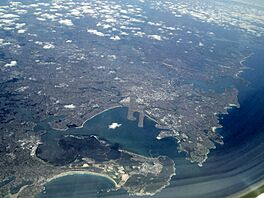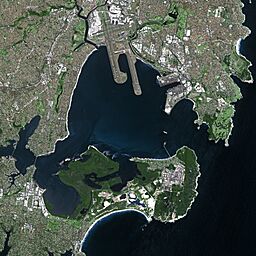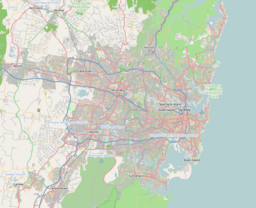Botany Bay facts for kids
Quick facts for kids Botany Bay |
|
|---|---|
| Kamay/Gamay, Sting Ray Harbour | |

Aerial photo of Sydney showing Botany Bay in the foreground.
The two protrusions into the bay are runways of Sydney Airport. |
|
 |
|
| Location | Sydney, New South Wales, Australia |
| Coordinates | 33°59′59″S 151°13′59″E / 33.99972°S 151.23306°E |
| Type | Bay |
| Primary inflows | Georges River, Cooks River |
| Primary outflows | Tasman Sea |
| Catchment area | 54.9 km2 (21.2 sq mi) |
| Max. length | 10 km (6.2 mi) |
| Surface area | 39.6 km2 (15.3 sq mi) |
| Average depth | 11.4 m (37 ft) |
| Water volume | 440,815,800 m3 (1.556726×1010 cu ft) |
Botany Bay (called Kamay by the Dharawal) is a large bay in Sydney, New South Wales, Australia. It's about 13 kilometers south of the main city area. The Georges River and Cooks River flow into it. The bay then opens up to the Tasman Sea.
Even though it's not very deep, Botany Bay is a very important seaport for Sydney. It's called Port Botany. You can also see two runways of Sydney Airport stretching out into the bay. Parts of the bay are protected as Kamay Botany Bay National Park.
Contents
History of Botany Bay
Who Lived Here First?
For thousands of years, Aboriginal people lived around Botany Bay. The Tharawal and Eora peoples were among them. They had many different clans. The Gweagal clan lived on the south side of the bay. The Gameygal clan lived on the north side.
The Aboriginal name for Botany Bay is Kamay. Evidence shows people lived here about 5,000 years ago.
When Europeans Arrived
On April 29, 1770, James Cook was the first European to land in Botany Bay. He arrived on his ship, HMS Endeavour. This landing was the start of Britain's interest in Australia. Cook first called the bay Stingrays Harbour. This was because he and his crew caught many stingrays there.
Later, Cook changed the name to Botany Bay. He did this because his scientists, Joseph Banks and Daniel Solander, found many new plants there. That's why nearby places are named after them, like Cape Banks and Cape Solander.
Eighteen years later, in January 1788, Governor Arthur Phillip arrived with the First Fleet. This fleet carried the first European settlers and convicts. They planned to start a penal colony (a place for prisoners) here.
However, Phillip soon found that Botany Bay was not a good place for a settlement. There wasn't enough fresh water. The land was swampy and the soil was poor. The bay was also too open and not safe for ships. So, Phillip decided to move the settlement.
He moved the fleet north to Port Jackson, which had a much better natural harbor. This new settlement became Sydney Cove. Even though the colony moved, for a long time, people in Britain still called Australia "Botany Bay."
On January 24, 1788, a French exploration team led by Jean-François de Galaup, comte de Lapérouse was seen outside Botany Bay. On January 26, the British ships left for Sydney Cove. The French ships then entered Botany Bay.
For many years, the western side of Botany Bay remained mostly untouched. It was hard to get there until a road was built from Canterbury. This road is now called Illawarra Road.
What Can You See at Botany Bay Today?
Busy Airport and Port
Sydney Airport, Australia's busiest airport, is on the northwest side of Botany Bay. Some of its runways actually extend into the bay. After World War II, the mouth of the Cooks River was moved to make space for the airport's expansion.
Port Botany is east of the airport. It has large terminals for shipping containers. These terminals are where huge ships load and unload goods. It's the biggest container port in Sydney.
Nature and Beaches
The land around the bay's entrance is part of Kamay Botany Bay National Park. This park helps protect the natural environment. On the northern side of the bay's mouth is the historic area of La Perouse. To the south is Kurnell.
Even though there's a national park, the southern shore also has some big industrial sites. These include a desalination plant (which turns seawater into fresh water) and a fuel terminal.
The western shores of the bay have many popular swimming beaches. One of these is Lady Robinsons Beach. You can also find old military bunkers around Botany Bay. These were built during World War II and are still there.
Amazing Marine Life
Botany Bay is home to many different kinds of sea creatures. The area near the bay's entrance is a popular spot for scuba diving. In 2008, a group called the Botany Bay Watch Project started. Volunteers help to look after the bay and its unique marine life.
One special creature found here is the weedy sea dragon. The largest group of these amazing fish in the world lives at a dive site near Kurnell. The eastern blue groper is another common fish in the bay. It's the state fish of New South Wales and is known for being very friendly to divers.
Gallery
-
The mouth of Botany Bay as it meets the Tasman Sea, as viewed from the air, above Kurnell
-
Botany Bay, view from Kurnell
-
Bicentennial Monument at Brighton-Le-Sands
-
Sydney Airport runway near Botany Bay beach
-
Sydney CBD skyline viewed from Botany Bay
See also
 In Spanish: Bahía de Botany para niños
In Spanish: Bahía de Botany para niños









